You’re never “too young” for a heart-healthy lifestyle
When it comes to having a healthy heart, it’s important to know your numbers. Even if you’re in your 20s or 30s, you’re not “too young” to start making heart-healthy food and lifestyle choices. Two of my friends who wrestled with heart disease experienced two different outcomes. One—a hard-driving 37-year-old tech entrepreneur, who was motivated to change his diet and a few bad habits after his heart attack—survived. The other, a talented 46-year-old photographer, who lived and ate on-the-run—working long hours and sleeping too little—unexpectedly died of a cardiac arrest during a conference he was attending.
In heart disease research, younger groups (between ages 25-55) have historically been considered “low risk”. This may be changing. In a 2015 study published last year in Circulation, researchers tracked heart disease death rates among adults aged 25 years and older. Between 1979 and 2011, heart disease deaths fell dramatically among those over age 65. However, there was considerably less improvement in heart disease death rates among those under age 55, especially for women—attributed to increasing rates of diabetes and obesity in younger adults, as well as non-traditional risk factors, such as stress and depression, common among young women with early-onset heart disease.
Symptoms of inflammation (and why it matters)
The sooner you get familiar with your numbers, the greater your success in lowering—even reversing—your risk for heart disease, as well as other chronic conditions and diseases.
The most relevant numbers are markers of inflammation.
Why? Inflammation is your body’s response to stress—whether from your diet, lifestyle or environment. Think of what happens when you sprain your ankle or burn your hand: you experience immediate pain, swelling and redness.

This kind of acute inflammation is good, but our modern, convenience-oriented lifestyle contributes to an epidemic of chronic, low-grade inflammation that most of us experience in the form of skin disorders (rashes, “adult acne”, eczema, psoriasis), joint aches and pains, chronic headaches, digestive distress, IBS, allergies, or fatigue—our body’s way of communicating with us that things are out of balance.When your body’s systems experience a constant inflammatory response, you are more susceptible to accelerated aging (internally and externally) and chronic diseases and conditions, including heart disease, stroke, cancer, diabetes, obesity and arthritis.
One of the main factors contributing to chronic low-grade inflammation are the foods that we eat. Typical culprits include sugar, junk food / processed / fast foods, gluten, grains and dairy.
Markers of Inflammation: Know your numbers!
You will also want to get familiar with other markers of inflammation (see list below).
High Sensitivity C-Reactive Protein (hs-CRP). Your level of CRP increases in response to inflammation. Higher levels of CRP are linked with greater risk of heart attack. Ideally, your hs-CRP is <1.0 mg/L (low risk for developing cardiovascular disease). An hs-CRP level of >3.0 indicates high risk for heart disease. *Note: “Normal” values may vary slightly among different labs.
Vitamin D (25-hydroxy vitamin D). Recent studies link low levels of vitamin D to an increased risk of heart disease. Optimal vitamin D levels are between 50-70 ng/ml. In cases of cancer or heart disease, the recommended level is even higher: 70-100 ng/ml.
Hemoglobin A1c. If you have a family history of diabetes, heart disease or overweight / obesity this is an important number to know. This is a blood test that reflects your average blood sugar level for the past 2-3 months. Optimal is <5.7% (low risk of diabetes). An A1c of 6.5% or higher indicates diabetes.
Homocysteine. At high levels, homocysteine, an amino acid, can damage the lining of the arteries and promote blood clotting, raising your risk for heart disease, heart attacks, blood clots and strokes. Ideally, your homocysteine levels are below 15 mmol/L. Above 15mmol/L is considered “high”.
Metabolic Syndrome
This is a group of risk factors that raises your risk of heart disease, stroke and diabetes. Three (3) or more of these risk factors (listed below) = metabolic syndrome = increased risk of heart disease.

1. Large waist size. This indicates excess body fat around the waist.
–For men: 40 inches or larger
–For women: 35 inches or larger
2. High triglycerides.
Your triglycerides are 150 mg/dL or higher OR You are using a cholesterol medicine
3. Low HDL “good” cholesterol.
–For men: Your HDL is less than 40 mg/dL
–For women: Your HDL is less than 50 mg/dL
4. High blood pressure.
Your blood pressure is 135/85 mm Hg OR You are using high blood pressure medicine
5. High fasting blood glucose. *This is a leading indicator of inflammation.
Optimal: your fasting blood glucose is less than 85 mg/dL. Note: most labs define “normal” as under 100 mg/dL.
*Note: If your blood glucose level is between 100 and 125 mg/dL, you have pre-diabetes. At this point, it is still possible — and important —to make diet and lifestyle changes to prevent pre-diabetes from developing into Type 2 diabetes.
Get Guidance and Support
Need help making sense of your numbers? Contact me to schedule a Lab Consultation. Or, if you want to be pro-active in improving your numbers, consider my video-only service: Optimize Your Wellness.
Related Articles
Chronic Inflammation and Your Immune Health
How to Naturally Reduce Stress-Induced Weight
7 Reasons You’re Not Losing Weight


